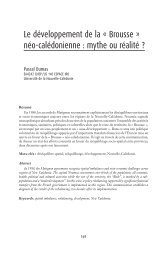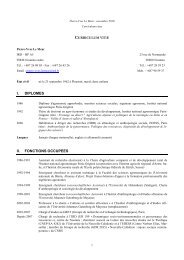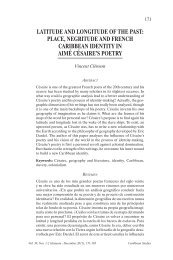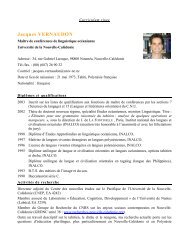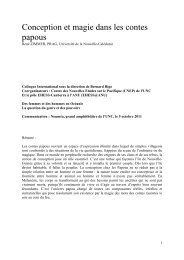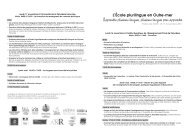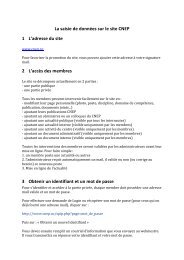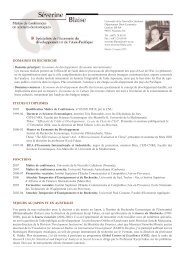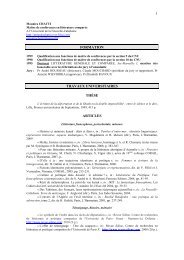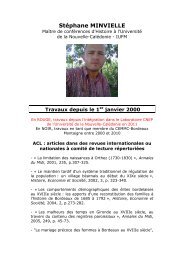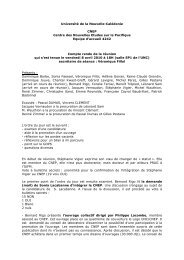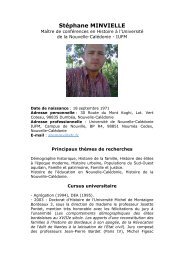assessment of soil erosion using usle model and gis for integrated ...
assessment of soil erosion using usle model and gis for integrated ...
assessment of soil erosion using usle model and gis for integrated ...
You also want an ePaper? Increase the reach of your titles
YUMPU automatically turns print PDFs into web optimized ePapers that Google loves.
Fig. 9: Potential <strong>soil</strong> loss <strong>erosion</strong> in the study area. The high estimations <strong>of</strong> <strong>soil</strong> loss correspond primarily at thetop hills <strong>of</strong> the “Central Chain”. They are the result <strong>of</strong> the combination <strong>of</strong> steep slopes, high precipitation, altered<strong>soil</strong>s <strong>and</strong> bare <strong>soil</strong>s due to human activities, such as mining activities.V/ CONCLUSION AND DISCUTIONSoil <strong>erosion</strong> is a serious problem in New-Caledonia mainly due to the cyclonic tropicalweather, bush fires <strong>and</strong> human activities such as openpit mining. Run<strong>of</strong>f on stripped <strong>soil</strong>scauses degradations <strong>for</strong> anthropic laying out on high ultramafic terranes <strong>and</strong> pollution(mobilized <strong>soil</strong> particles) which modifies the coastal region <strong>and</strong> degrades the coral reefs byhypersedimentation processes. All the human activities chain that depend on natural resourcesregularly suffer the effects or the consequences <strong>of</strong> these phenomena. The situation, not <strong>for</strong> thesame reasons <strong>and</strong> not in the same proportions, is similar in others high isl<strong>and</strong>s <strong>of</strong> the SouthPacific such as Efate isl<strong>and</strong> in Vanuatu (Dumas <strong>and</strong> Fossey, 2009). These countries need toidentify <strong>and</strong> rank <strong>erosion</strong> risk <strong>and</strong> define sensitivity maps, particularly <strong>for</strong> decisionmakers. Inthis case, the USLE <strong>model</strong> can be useful <strong>for</strong> processing the potential <strong>soil</strong> <strong>erosion</strong> mapping at aregional scale, implemented with some data not too complex <strong>and</strong> compatible with theirintegration into a Geographical In<strong>for</strong>mation System (GIS), generally available in the Pacificcountries as a digital elevation <strong>model</strong>, a <strong>soil</strong> map, precipitation data or satellite images. Theuse <strong>of</strong> GIS becomes an important <strong>and</strong> powerful tool <strong>for</strong> the implementation <strong>of</strong> this <strong>model</strong>. TheUSLE equation used lead a better underst<strong>and</strong>ing <strong>of</strong> spatial distribution <strong>of</strong> the <strong>erosion</strong> hazard.Moreover, a comparison with a multi-criteria method (expert approach) demonstrates thatresults obtained in term <strong>of</strong> spatial variation are similar (Dumas et al., 2009). But the values <strong>of</strong><strong>soil</strong> loss from USLE should be considered as an order <strong>of</strong> magnitude <strong>and</strong> not as absolutevalues. In fact, USLE <strong>model</strong> is useful to identify risks areas <strong>and</strong> catchments that are moresensitive to <strong>erosion</strong>. This type <strong>of</strong> mapping should be relevant to classify the reef zone mostaffected by hypersedimentation hazard. Within the framework <strong>of</strong> Integrated Coastal ZoneManagement, the areas most affected by <strong>erosion</strong> will be classified as priority managementareas so as to limit their impacts on the marine environment.ACKNOWLEDGMENTSThe authors would like to acknowledge the support <strong>of</strong> CRISP program (Coral ReefsInitiatives <strong>for</strong> the Pacific) <strong>for</strong> funding this research project.9



